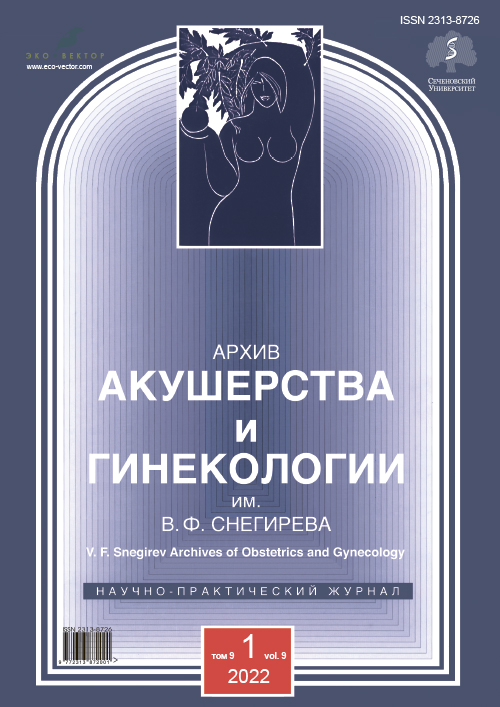Effectiveness of the choice of the optimal method for surgical treatment of genital prolapse
- Authors: Musin I.I.1, Yashchuk A.G.1, Urmantsev M.F.1, Berg E.A.1, Molokanova A.R.1, Berg P.A.1
-
Affiliations:
- Bashkir State Medical University
- Issue: Vol 9, No 1 (2022)
- Pages: 49-55
- Section: Original study articles
- Submitted: 17.02.2022
- Accepted: 17.02.2022
- Published: 15.01.2022
- URL: https://archivog.com/2313-8726/article/view/100983
- DOI: https://doi.org/10.17816/2313-8726-2022-9-1-49-55
- ID: 100983
Cite item
Abstract
AIM: This study aimed to evaluate the effectiveness of the choice of surgical method for treating genital prolapse, depending on the intensity of pelvic floor tissue perfusion.
MATERIALS AND METHODS: The study assessed the relationship of extragenital pathology, medical history of women operated for genital prolapse and medical history of women without genital prolapse during peri- and post-menopause (control group, n=67) with indicators of vaginal perfusion intensity. Overall, 328 patients with pelvic organ prolapse (II–IV degree) underwent surgery according to the Pelvic Organ Prolapse Quantification system. Of these, 287 patients were examined after 2 years to diagnose disease recurrence; these patients were included in the main study group (n=287). For statistical processing of the obtained results, the STATISTICA 10.0 and EViews 12.0 software packages were used.
RESULTS: Correlation analysis revealed an inverse relationship between vaginal microcirculation intensity with age (rs=−0.187; р=0.025), menopause duration (rs=−0.390; р=0.001), genital prolapse duration (rs=−0.245; р=0.046), and surgical menopause (rs=−0.442; р <0.001). The study of microcirculation intensity in the anterior and posterior vaginal walls, depending on the presence of somatic diseases, revealed an inverse correlation with diseases such as hypertension (rs=−0.291; р <0.001), coronary heart disease (rs=−0.169; р=0.044), and diabetes mellitus (rs=−0.223; р=0.008). When choosing a method of surgical treatment that minimizes the contact of mesh prosthesis with native tissues in women with comorbid pathology, a relapse of the disease after 2 years was detected in only 2.4% women.
CONCLUSION: The choice of the optimal method for treatment in patients with somatic burden and low perfusion capacity of pelvic organs and tissues can reduce the number of complications after surgical treatment of pelvic prolapse.
Keywords
Full Text
About the authors
Il’nur I. Musin
Bashkir State Medical University
Author for correspondence.
Email: ilnur-musin@yandex.ru
ORCID iD: 0000-0001-5520-5845
MD, Cand. Sci. (Med.), Associate Professor of the Department of Obstetrics and Gynecology
Russian Federation, 3 Lenin Street, Ufa, 450112, Republic of BashkortostanAl’fiya G. Yashchuk
Bashkir State Medical University
Email: ilnur-musin@yandex.ru
ORCID iD: 0000-0003-2645-1662
M.D., Dr. Sci. (Med.), professor, Head of the Department of Obstetrics and Gynecology
Russian Federation, 3 Lenin Street, Ufa, 450112, Republic of BashkortostanMarat F. Urmantsev
Bashkir State Medical University
Email: urmantsev85@mail.ru
ORCID iD: 0000-0002-4657-6625
MD, Cand. Sci. (Med.), Associate Professor
Russian Federation, 3 Lenin Street, Ufa, 450112, Republic of BashkortostanEdvard A. Berg
Bashkir State Medical University
Email: aig.eaberg@gmail.com
ORCID iD: 0000-0002-2028-7796
assistant at Department of Obstetrics and Gynecology
Russian Federation, 3 Lenin Street, Ufa, 450112, Republic of BashkortostanAnzhella R. Molokanova
Bashkir State Medical University
Email: ilnur-musin@yandex.ru
ORCID iD: 0000-0003-1115-6775
graduate student
Russian Federation, 3 Lenin Street, Ufa, 450112, Republic of BashkortostanPolina A. Berg
Bashkir State Medical University
Email: kovalenko.polina93@yandex.ru
assistant of the Department of Obstetrics and Gynecology
Russian Federation, 3 Lenin Street, Ufa, 450112, Republic of BashkortostanReferences
- Buyanova SN, Shchukina NA, Dub NV, Chechneva MA, Zemskova NYu. Clinical signs, diagnosis and treatment of complex and mixed forms of Urinary incontinence in women. Moscow: Adamant; 2012. (In Russ).
- Ishchenko AA, Ishchenko AI, Aleksandrov LS, Gilyadova AV. Possibilities of the implementation of surgical interventions aimed at correcting the prolapse of pelvic organs, in the conditions of the gynecological department of the municipal maternity hospital. V.F. Snegirev Archives of Obstetrics and Gynecology. 2018:5(2):83–87. (In Russ). doi: 10.18821/2313-8726-2018-5-2-83-87
- Isık H, Aynıoglu O, Sahbaz A, et al. Are hypertension and diabetes mellitus risk factors for pelvic organ prolapse? Eur J Obstet Gynecol Reprod Biol. 2016;197:59-62. doi: 10.1016/j.ejogrb.2015.11.035
- Kerkhof MH, Hendriks L, Brölmann HAM. Changes in connective tissue in patients with pelvic organ prolapse ― a review of the current literature. Int Urogynecol J Pelvic Floor Dysfunct. 2009;20(4):461–474. doi: 10.1007/s00192-008-0737-1
- Cooper J, Annappa M, Dracocardos D, et al. Prevalence of genital prolapse symptoms in primary care: a cross-sectional survey. Int Urogynecol J. 2014;26(4):505–510. doi: 10.1007/s00192-014-2556-x
- Cao Q, Chen YS, Ding JX, et al. Long-term treatment outcomes of transvaginal mesh surgery versus anterior-posterior colporrhaphy for pelvic organ prolapse. Aust N Z J Obstet Gynaecol. 2013;53(1):79–85. doi: 10.1111/ajo.12040
- Weber MA, Milstein DM, Ince C, Roovers JP. Is pelvic organ prolapse associated with altered microcirculation of the vaginal wall? Neurourol Urodyn. 2016;35(7):764–770. doi: 10.1002/nau.22805
- Vashaghian M, Zaat SJ, Smit TH, Roovers JP. Biomimetic implants for pelvic floor repair. Neurourol Urodyn. 2018;37(2):566–580. doi: 10.1002/nau.23367
- Swenson CW, Simmen AM, Berger MB, Morgan DM, DeLancey JO. The long and short of it: anterior vaginal wall length before and after anterior repair. Int Urogynecol J. 2015;26(7):1035–1039. doi: 10.1007/s00192-015-2636-6
- Maher C, Baessler K, Glazener CM, Adams EJ, Hagen S. Surgical management of pelvic organ prolapse in women. Cochrane Database Syst Rev. 2004;(4):CD004014. doi: 10.1002/14651858.CD004014.pub2
Supplementary files







